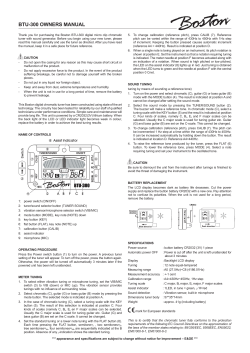
Specifications
TK-40B Preamp Technical Specifications TK-40B Power Supply : 9 Volt Output : 280 mV EQ Control : BASS (60Hz) : BASS (60Hz) : MIDDLE(400Hz) : MIDDLE(1KHz) : TREBLE(10KHz) : ± 12dB + 8dB / -11dB (Bass Boost Switch ON) ± 12dB (Mid shift Volume 400Hz) ± 12dB (Mid shift Volume 1KHz) ± 12 dB Bass Boost (60Hz) On : + 8dB Low Battery : 7.0 Volt Current : 0.7mA (tuner on 10mA) Auto chromatic Tuner Tuning Range : C1(32.703Hz)~B7(3951.07Hz) Accurary : ±1 Cent Tuner auto off time : 2 minutes Tuner switch function Single Press of tuner switch : TUNER ON Second Press of tuner switch : CALIBRATE TO PITCH Press and Hold Switch : TUNER OFF Owner’s Guide Publication Number: Get the Most from Your Guitar The Takamine TK-40B acoustic bass guitar preamp is designed specifically for your Takamine guitar to provide the flexibility and control you need in almost any performance or recording environment. The no-nonsense approach to functionality results in an amazingly transparent, responsive, and easy-to-use preamp that will let you “dial in” your sound in moments. d Volume: Turning this control clockwise increases the output level of the preamp. e Mid shift: Tunes the midrange EQ center frequency (see below) from 400Hz to 1000Hz. This gives you the flexibility to enhance or reduce the midrange content of your signal at just the right segment of the sound spectrum. The dot on the control legend represents the preferred frequency for most players. f Tuner: This button controls the built-in tuner’s on/off function. Simply press the button once to activate the tuner (even if the guitar is not plugged in) and the tuner display c will light. When you play a string the tuner will display the note name of the pitch you’re playing. Then, simply adjust the pitch of your strings in the direction of the flashing up or down arrow to the right of the note name. As you approach the correct pitch, the flashing speed slows until you are in tune and both the arrows illuminate to form a diamond. The Anatomy of the TK-40 The Takamine TK-40B preamp is designed to be easy to use, yet flexible enough any application. Please refer to the figure below which will provide you with an easy reference for the function and use of each control and feature. a c b F When the tuner is active, pressing the tune button a second time enables you to tune to a arbitrary reference pitch. For example, if you are attempting to play with some other out-of tune instrument, tune one string of your guitar to that instrument while the tuner is on. Once tuned, press the Calibrate button and the tuner will adjust its reference frequency allowing you to tune the rest of your strings accurately. When the tuner is turned off, it will revert to the standard A=440Hz setting. h d To save battery power, the tuner will automatically turn off after about two minutes of operation and may be reactivated by pushing the tuner button again. If you finish tuning before the tuner automatically turns off, you may turn off the tuner manually by simply holding down the tuner button for at least two seconds. e g f a Battery Tray Releses: Pinching the tabs of battery cover toward each other to remove. This provides access to the battery compartment. When inserting new batteries align the battery's polarity with the marking inside the battery compartment. b Bat-check: Pressing the Bat-Check button allows you to assess the voltage of your battery. If the LED illumintates, the battery power is sufficient to run the preamp. If the LED does not illuminate, the voltage is low enough to effect the quality of your sound and the battery should be replaced. g EQ Controls: The TK-40B features a three-band equalizer with an adjustable frequency midrange control (see above). A three-band equalizer allows tonal adjustment with a maximum of 12dB of boost or cut in a designated spectrum. The “Low” controls works in the bass range, the “High” works in the treble range, while the “Mid” control will allow you to adjust the boost/cut at the working frequency in conjunction with the Mid Shift. knob. The EQ Bypass switch, to the right, allows you to take the equalizer out of the signal processing chain for an unaltered “direct” sound, ideal for external equalization. h Bass Boost: Engaging the Bass Boost enables you to experience smooth, boosted low-end frequencies by simply pressing a button.
© Copyright 2025









